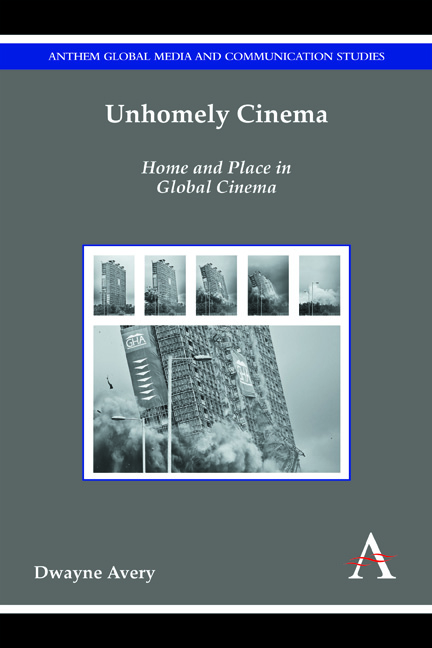Book contents
- Frontmatter
- Contents
- Introduction Unhomely Cinema
- Chapter 1 An Unhomely Theory
- Chapter 2 The Decline of the Family: Home and Nation in Krzysztof Kieślowski's The Decalogue
- Chapter 3 The Future Is behind You: Global Gentrification and the Unhomely Nature of Discarded Places
- Chapter 4 No Place to Call Home: Work and Home in Paul Thomas Anderson's Punch Drunk Love and Jason Reitman's Up in the Air
- Chapter 5 The Terrible Lightness of Being Mobile: Cell Phone and the Dislocation of Home
- Chapter 6 Unhomely Revolt in Laurent Cantet's Time Out
- Conclusion
- References
- INDEX
Introduction - Unhomely Cinema
Published online by Cambridge University Press: 05 November 2014
- Frontmatter
- Contents
- Introduction Unhomely Cinema
- Chapter 1 An Unhomely Theory
- Chapter 2 The Decline of the Family: Home and Nation in Krzysztof Kieślowski's The Decalogue
- Chapter 3 The Future Is behind You: Global Gentrification and the Unhomely Nature of Discarded Places
- Chapter 4 No Place to Call Home: Work and Home in Paul Thomas Anderson's Punch Drunk Love and Jason Reitman's Up in the Air
- Chapter 5 The Terrible Lightness of Being Mobile: Cell Phone and the Dislocation of Home
- Chapter 6 Unhomely Revolt in Laurent Cantet's Time Out
- Conclusion
- References
- INDEX
Summary
Going Home: The Problem of Dwelling in Contemporary Film
District 9 is a politically charged science fiction film that was released in 2009. Set in the volatile world of Johannesburg, South Africa, the film tells the story of a group of insectoid aliens (called Prawns) that get stranded on Earth when their spacecraft loses an important command module. Like most space invader films, District 9 utilizes a simple narrative opposition: as a group of inexplicable outsiders, the aliens form an imminent danger that must be excised immediately by the humans; however, while District 9 follows this traditional narrative structure, its low-fi, even quotidian treatment of the alien invasion distinguishes it from most contemporary science fiction films. Unlike many high-octane sci-fi films, that all too often portray the aliens as a formidable military force that is ready and willing to decimate the human race, in District 9 the enthralling and sensationalistic powers of military technology are permanently sidelined. In short, there are no impressive intergalactic battle scenes; no explosive displays of military technology and violence. Neither are there any awe-inspiring scientific breakthroughs that allow the humans to vanquish the aliens and save humankind. Quite the contrary, instead of cunning and intelligent creatures the Prawns are portrayed as pathetic beings that are barely able to sustain themselves, let alone wage a massive assault on the human race.
- Type
- Chapter
- Information
- Unhomely CinemaHome and Place in Global Cinema, pp. 1 - 8Publisher: Anthem PressPrint publication year: 2014



